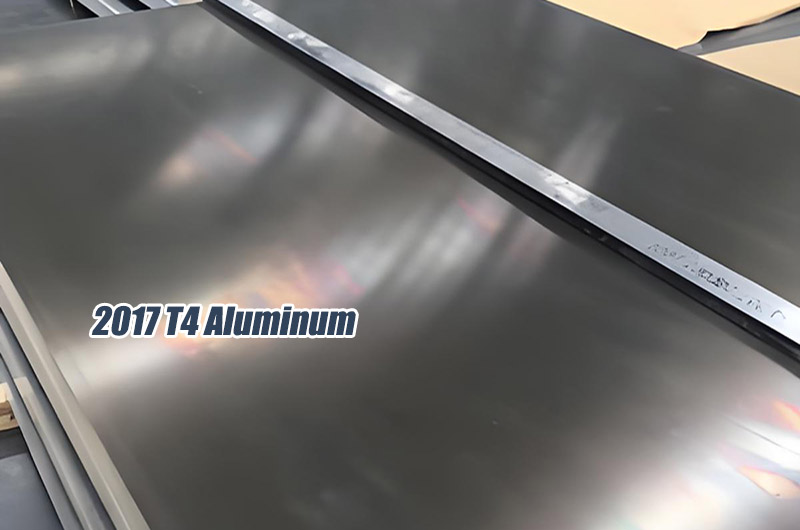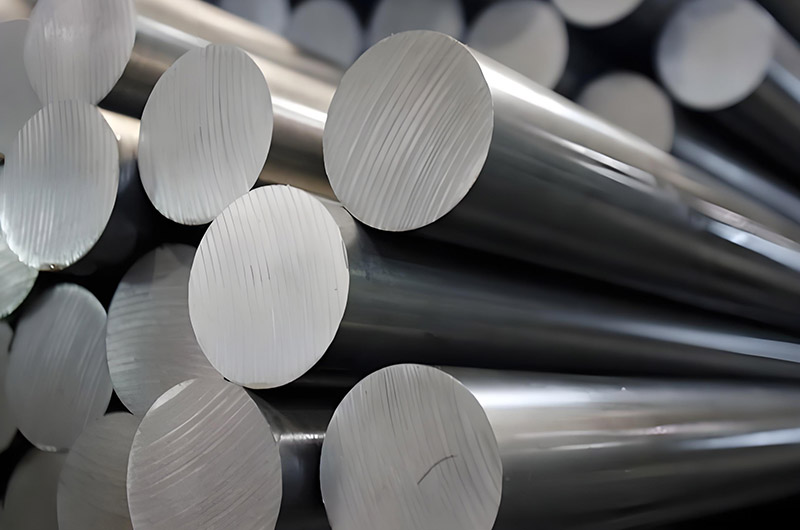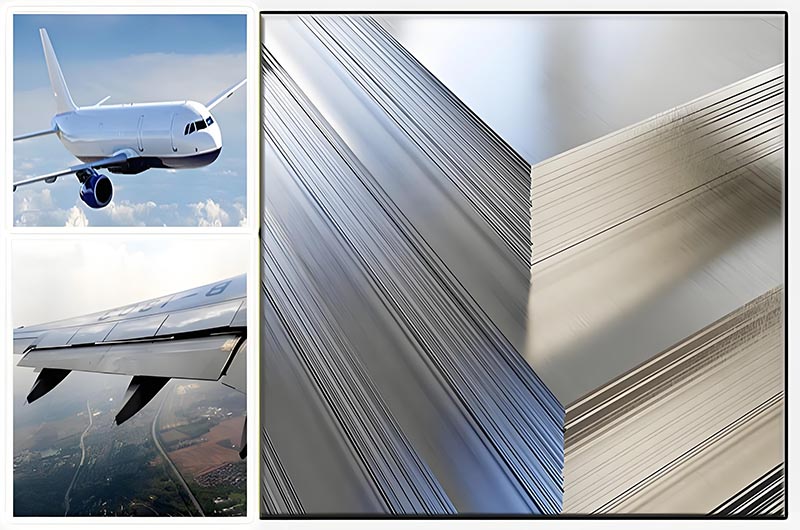2017 T4 Aluminum
2017 T4 aluminum is a type of 2000 series aluminum alloy, where copper is the primary alloying element. In the T4 condition, the alloy undergoes solution heat treatment and is then naturally aged to a stable state. This process gives the material a good balance of strength and ductility, making it particularly suitable for precision machining and structural applications.
2017 T4 aluminum combines high strength, excellent ductility, and good machinability. Its specific T4 condition makes it particularly suitable for precision machining and applications where reliable performance under stress is crucial. Although its corrosion resistance is moderate (partially due to its copper content), its overall performance makes it a preferred choice for high-performance structural and aerospace components.

2017-T4 aluminum alloy is the T4 form of 2017 aluminum alloy. To achieve this state, 2017 aluminum alloy is first subjected to solution heat treatment and then undergoes a natural aging process. The solution heat treatment usually involves heating the aluminum alloy to a high temperature to evenly distribute the solute elements in the alloy, followed by rapid cooling. During the subsequent natural aging phase, the metal slowly ages at room temperature, eventually reaching its optimal ductility and mechanical properties.
Compared to other heat-treated states of 2017 aluminum alloy, such as T6 or T3, the T4 temper has the highest ductility. Ductility refers to the material's ability to deform under external forces, so T4-treated 2017 aluminum alloy is highly valuable for applications that require good formability or ease of processing. This alloy is commonly used in the manufacturing of components that require deep forming or complex processing, such as structural parts in aerospace, transportation, and mechanical industries.
Although 2017 aluminum in the T4 temper has excellent ductility, its strength is relatively lower. To achieve higher strength, other heat-treated states, such as T6, may be needed. However, for applications that require excellent processing performance, the T4 temper still offers irreplaceable advantages.
2017 Aluminum Temper (T4)
- Process: 2017 alloy undergoes solution heat treatment and is then naturally aged at room temperature.
- Effect: Balances strength and ductility; T4 strength is lower than artificially aged temper (such as T6), but formability is better.
- Characteristics: This temper provides the highest ductility in the 2017 variant, with a good balance between strength and machinability.
2017 T4 Aluminum Standards and Designations
Aluminium 2017-T4; UNS A92017; ISO AlCuMgSi; AA2017-T4, Aluminium 2017-T451; QQ-A-4300; QQ-A-222/5; CM41 (Canada); NF A-U46 (France); MIL-R-430; AA2017-T451; Al2017-T4
2017 T4 Aluminum Supplied Forms
| Form | Description | Common Uses | Key Characteristics |
| 2017-T4 Aluminum Plate | Thick, flat section of aluminum used for structural components requiring high strength. | Aircraft fuselage panels Aerospace structures Pressure vessels Military components | High strength Good machinability Moderate corrosion resistance Can be further processed |
| 2017-T4 Aluminum Sheet | Thin, flat section of aluminum, often used for lighter structural components. | Aircraft wing and fuselage skin Aerospace cladding Lightweight structural parts | Lightweight High strength-to-weight ratio Good formability Moderate corrosion resistance |
| 2017-T4 Aluminum Square Bar | Solid, square-shaped extrusion or rod used for precision machining and structural parts. | Aircraft parts Aerospace structures Tooling and fixtures | Easy to machine High strength Can be welded (requires pre-weld treatment) Moderate SCC risk |
| 2017-T4 Aluminum Round Bar | Solid, cylindrical form, ideal for making round components, shafts, and pins. | Aircraft shafts, pins, rods Aerospace machinery High-stress structural parts | High strength Excellent for machining Good fatigue resistance Moderate corrosion resistance |
| 2017-T4 Aluminum Hex Bar | Solid, hexagonal-shaped extrusion used for parts that require additional surface area or a specific geometry. | Aerospace structural parts Machine components Fasteners and high-strength parts | High machinability Good mechanical properties Used in high-strength applications |
| 2017-T4 Aluminum Profile | Custom or standard extruded sections with various shapes, used for structural components and frames. | Aerospace frames Aircraft interior supports Industrial machinery frames | Customizable shapes High strength and lightweight Ideal for complex designs |

2017 T4 Aluminum Material Property Data Sheet
| Physical Properties | Metric | English | Comments |
| Density | 2.79 g/cc | 0.101 lb/in³ | AA; Typical |
| 2017 T4 Aluminum Mechanical Properties | |||
| Hardness, Brinell | 105 | 105 | AA; Typical; 500 g load; 10 mm ball |
| Hardness, Knoop | 132 | 132 | Converted from Brinell Hardness Value |
| Hardness, Rockwell A | 42.5 | 42.5 | Converted from Brinell Hardness Value |
| Hardness, Rockwell B | 66 | 66 | Converted from Brinell Hardness Value |
| Hardness, Vickers | 118 | 118 | Converted from Brinell Hardness Value |
| Ultimate Tensile Strength | 427 MPa | 62000 psi | AA; Typical |
| Tensile Yield Strength | 276 MPa | 40000 psi | AA; Typical |
| Elongation at Break | 22 % | 22 % | AA; Typical; 1/2 in. (12.7 mm) Diameter |
| Modulus of Elasticity | 72.4 GPa | 10500 ksi | AA; Typical; Average of tension and compression. Compression modulus is about 2% greater than tensile modulus. |
| Poisson's Ratio | 0.33 | 0.33 | Estimated from trends in similar Al alloys. |
| Fatigue Strength | 124 MPa | 18000 psi | AA; 500,000,000 cycles completely reversed stress; RR Moore machine/specimen |
| Machinability | 70 % | 70 % | 0-100 Scale of Aluminum Alloys |
| Shear Modulus | 27 GPa | 3920 ksi | Estimated from similar Al alloys. |
| Shear Strength | 262 MPa | 38000 psi | AA; Typical |
| 2017 T4 Aluminum Electrical Properties | |||
| Electrical Resistivity | 5.15e-006 ohm-cm | 5.15e-006 ohm-cm | AA; Typical at 68°F |
| 2017 T4 Aluminum Thermal Properties | |||
| CTE, linear 68°F | 23.6 µm/m-°C | 13.1 µin/in-°F | AA; Typical; Average over 68-212°F range. |
| CTE, linear 250°C | 25.4 µm/m-°C | 14.1 µin/in-°F | Estimated from trends in similar Al alloys. 20-300°C. |
| Specific Heat Capacity | 0.88 J/g-°C | 0.21 BTU/lb-°F | Estimated from trends in similar Al alloys. |
| Thermal Conductivity | 134 W/m-K | 930 BTU-in/hr-ft²-°F | AA; Typical at 77°F |
| Melting Point | 513 641 °C | 955 1185 °F | AA; Typical range based on typical composition for wrought products 1/4 inch thickness or greater. Eutectic melting is not eliminated by homogenization. |
| Solidus | 513 °C | 955 °F | AA; Typical |
| Liquidus | 641 °C | 1185 °F | AA; Typical |
| 2017 T4 Aluminum Processing Properties | |||
| Annealing Temperature | 338 349 °C | 640 660 °F | cold-work anneal |
| Annealing Temperature | 413 °C | 775 °F | heat treated anneal |
| Solution Temperature | 499 510 °C | 930 950 °F | |
| Aging Temperature | 22.2 °C | 72 °F | |
2017 T4 Aluminum Applications
| Field | Application | Description |
| Aerospace | Structural Components | 2017 T4 aluminum alloy is widely used in various structural components of the aerospace industry, such as wing frames, fuselage support members, and fasteners. Due to its high strength and good corrosion resistance, it can withstand the intense stresses and external environmental challenges encountered during aircraft flight. |
| Fittings | In aircraft interior fittings, 2017 T4 aluminum alloy is used to make parts that undergo significant loading, such as engine mounts, landing gear components, etc., due to its excellent strength and rigidity. | |
| Rivets | Aluminum alloy rivets are crucial in aerospace structures, and 2017 T4 aluminum alloy, with its high strength and excellent machinability, is one of the commonly used materials in aircraft riveting processes. | |
| Automotive | High-strength Components | 2017 T4 aluminum alloy is used to manufacture high-strength components like body frames, engine mounts, and drive shafts in automobiles. These parts must withstand vibrations, impacts, and other external forces during vehicle operation, requiring materials with excellent strength and fatigue resistance. |
| Industrial | Forged Components | 2017 T4 aluminum alloy is commonly used in the industrial sector for producing forged components, especially mechanical parts that need to bear high loads, such as gears, bearing housings, etc. Its high strength makes it suitable for these applications. |
| Screw Machine Products | 2017 T4 aluminum alloy is widely used in manufacturing screw machine products, particularly in applications requiring high wear resistance and load-bearing capacity. Its strength, wear resistance, and excellent machinability make it an ideal material for the screw machine industry. | |
| Military | Hardware and Mechanical Parts | In the military field, 2017 T4 aluminum alloy is used to manufacture various hardware and mechanical parts, including components for weapon systems, vehicle parts, ammunition boxes, and other high-strength structural parts. Its high strength and corrosion resistance make it suitable for harsh military environments. |
| Manufacturing | Fasteners | 2017 T4 aluminum alloy is widely used in manufacturing fasteners, including nuts, bolts, screws, etc., particularly in applications requiring high strength and resistance to high temperatures. It is easy to machine during production and can withstand significant tensile and compressive forces. |
| Rivets | Rivets have a wide application in many manufacturing industries, especially in high-strength requirements. 2017 T4 aluminum alloy rivets, due to their excellent strength and corrosion resistance, are widely adopted. | |
| Screw Machine Products | 2017 T4 aluminum alloy is also used in the manufacturing of high-strength screw machine products in the manufacturing industry, suitable for applications requiring high strength, durability, and corrosion resistance. | |
| Other | Transport Structural Components | 2017 T4 aluminum alloy is widely used in the transportation sector, especially in the manufacturing of structural components for vehicles such as cars, railways, ships, and aircraft. Its high strength, corrosion resistance, and machinability make it an ideal choice. |
| Mechanical Structural Components | 2017 T4 aluminum alloy is also widely used in the mechanical industry for structural components such as heavy machinery frames, supports, etc. It provides sufficient strength and durability to withstand the high-intensity work loads encountered by industrial equipment. |

2017 T4 Aluminum Corrosion Resistance
| Characteristics | Description |
| Lower than 3000/6000 series alloys | The corrosion resistance of 2017 T4 aluminum alloy is lower compared to the 3000 and 6000 series alloys. The 3000 series alloys are typically strengthened by manganese, offering excellent corrosion resistance, especially suitable for use in humid and marine environments. The 6000 series alloys contain silicon and magnesium, which form a dense oxide layer that helps resist corrosion. In contrast, 2017 T4 aluminum alloy is primarily strengthened by copper, which makes it less resistant to oxidation and corrosion compared to the 3000 and 6000 series alloys. This difference means that 2017 T4 aluminum alloy requires additional protective measures in corrosive environments. |
| Coatings required in corrosive environments (anodizing, paint) | To improve the durability of 2017 T4 aluminum alloy in corrosive environments, additional protective measures are typically required, such as applying an anodized layer or paint. Anodizing forms a dense oxide film on the aluminum surface, which not only enhances corrosion resistance but also improves wear resistance and oxidation resistance. A paint coating provides further protection, preventing moisture, salts, and other corrosive substances from coming into contact with the aluminum surface. With these coating treatments, 2017 T4 aluminum alloy can be used in harsh environments, extending its service life and reducing the damage caused by corrosion. |
2017 T4 Aluminum Machinability and Formability
| Characteristics | Description |
| Excellent machinability | 2017 T4 aluminum alloy has excellent machinability, especially suitable for automatic screw machine processing and the production of precision parts. Its good machining properties allow it to perform well in CNC machining, drilling, turning, milling, and other processes. Due to its low cutting forces and good surface finish, 2017 T4 aluminum alloy achieves high precision and production efficiency when manufacturing automatic screw machine parts and precision components, making it widely used in mechanical manufacturing and precision engineering fields with strict requirements. |
| High ductility and formability | 2017 T4 aluminum alloy has high ductility, contributing to its good formability. In processes like stamping, bending, and stretching, 2017 T4 aluminum alloy maintains excellent machinability, especially when manufacturing complex structural parts. However, due to its high copper content, 2017 T4 aluminum alloy has limited weldability and is generally only suitable for specialized welding techniques such as resistance welding to prevent a reduction in its corrosion resistance during welding. Therefore, special attention should be given to the welding process to ensure the strength and corrosion resistance of the welded joints. |
2017 T4 Aluminum Comparison
- 2017 vs. 2024: 2017 has better machinability; 2024 offers higher strength.
- T4 vs. T6: T4 is natural aging (lower strength, higher ductility); T6 is artificial aging (higher strength, lower ductility).
2017 T4 Aluminum Manufacturing and Processing
- Machinability: Excellent; suitable for high-speed machining.
- Welding: Poor weldability (prone to cracking); use riveting or adhesives.
- Forming: Best to complete before aging; T4 temper allows moderate cold working.
2017 T4 Aluminum Limitations
- Not recommended for welding or high-corrosion environments without protection.
- Lower fatigue resistance compared to 2024-T6.
This alloy is ideal for applications where machinability and moderate strength are prioritized, with appropriate corrosion protection measures in place.
